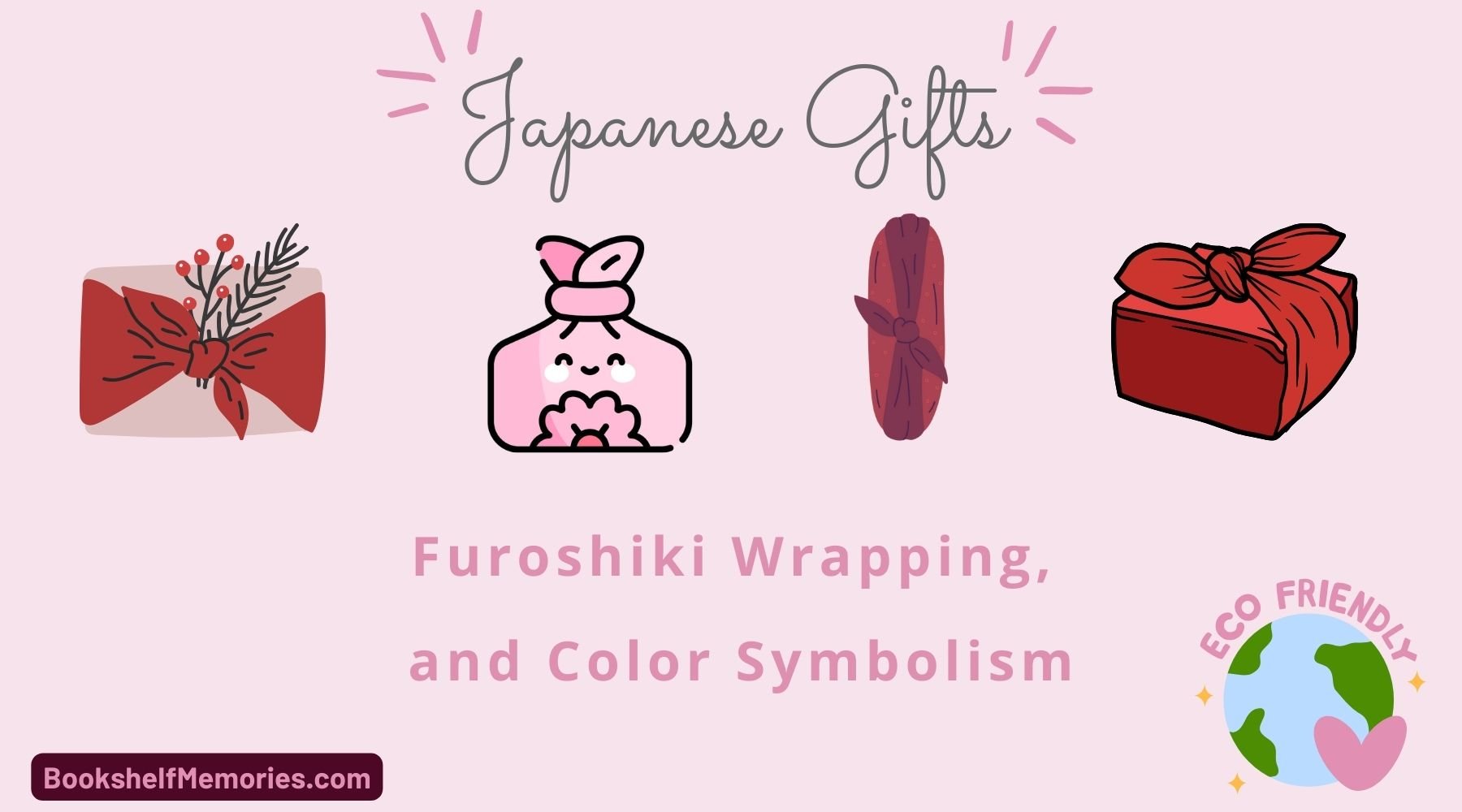The world can learn so much about the unique culture of Japanese gift giving. The type of gift is not as important as the gesture, and that gesture is appreciated more when consideration is given to the presentation. Customary to Japanese culture is minimal waste. Rather than using traditional paper, a re-usable cloth is used to wrap gifts. Gift wrapping is a Japanese art form in itself. It’s called Furoshiki, and its practice is being seen rising around the globe as a way to reduce single-use paper and plastics.
The Practice of Omiyage: More than a Souvenir

Omiyage is term used to describe souvenirs and every prefecture in Japan has omiyage that's unique to the area. So will your home town. When you visit Japan, it's customary to bring omiyage with you. Some people opt for non-perishable foods that's hard to get abroad like local delicacies, others think of things in their home town from an outsiders perspective and take unique collectibles to Japan to give to friends they make, or to nourish existing relationships.
For those with in-laws of Japanese heritage, or business trips to take to Japan, knowing the cultural significance of gift-giving, how they are presented, and the significance of color symbolism in Japan can help you give gifts with so much more meaning (and avoid potential awkward exchanges).
Color Symbolism in Japanese Culture
Red (Aka)

White (Shiro)
White signifies purity and it’s considered one of the sacred colors of the Gods, symbolizing spiritual purity and physical purity. Some of the cherry trees that Japan is famously known for, also produce white blooms. Not all are pink or the formal ‘cherry blossom red’. White is a safe color in Japan. In fact, almost half of all cars sold in Japan in 2023 were white. In Japanese paintings, white space symbolizes emptiness, and can mean a blank slate, or new beginnings. A staple in Japanese gardens and in the miniature landscapes like bonkeki, and bonteti, are white sand and white gravel. These are used to symbolize purity. In zen gardens, the white sand is used to represent water, which again, ties into purity. As a gift for someone starting a new chapter in their life, white is a good color scheme for the wrapping cloth, paper, or for the gift itself, a plain white journal if you know the person journals.
Black (Kuro)

Blue (Ao)

Green (Midori)

Green is another color in the lucky category, and it’s also one of the most significant colors in Japanese culture owing to the respect people have for nature. Green is a symbol of growth. Greenery Day in Japan is held on May 4th and it is a public holiday that happens to fall on the same week as Ichibancha - the first green tea harvest. In Japan, visiting a tea room on Greenery Day is customary because that’s when green tea will be tastiest. May 4th is a day to be with nature.
Orange (Orenji)

Purple (Murasaki)

Yellow (Kiiro)

Pink (Pinku)

Pink represents youthfulness, happiness, femininity, and good health. While Japan has no official national flower, it’s widely accepted that the cherry blossom is the countries national flower. In the spring is when cherry blossom trees bloom with vibrant pink petals. This is a symbol of renewal and optimism. In Japan, cherry blossom trees are called Sakura trees. Hanami is the custom of flower viewing. The largest hanami festival takes place in March/April when the trees come into bloom. Popular locations have food stalls setup with a variety of sweets, snacks, and Hanami-zake, which is the traditional Japanese rice wine.
Discover the Art of Furoshiki Gift Wrapping

Furoshiki gift wrapping is the Japanese version of Bojagi - a Korean wrapping cloth. Japan is great at importing techniques from other countries, putting a unique twist on it to create something beautiful. Furoshiki is one of those. Inherited at a time when fabric was much more expensive and labor intensive to produce, the fabric people had, they used it. Little went to waste. That practice is still maintained today.
Traditional fabrics would be silk and cotton, but in more modern times and with more people looking to minimize waste like single-use wrapping paper, polyester can do the same job. The concept is to use what you have if you can, and if you can’t, buy quality furoshiki fabrics that can be repurposed. In Japan, it’s customary to return the furoshiki to the giver. For recipients who may be unaware of that, attach a note on a gift tag asking politely to return the fabric for use again.
Explore the Plethora of Furoshaki Wrapping Styles

By Simona (Flickr) | CC BY-NC 2.0
There are various Furoshaki wrapping techniques. They’re essentially using fabric for origami to create gorgeous presentations for gifts. Here’s a list of some of the most popular Furoshaki techniques, and the resources to learn how to use them.
1. Otsukai
This is by far the simplest. Start with a piece of fabric that’s at least three times the size of the gift and lay it out diagonally. Place the gift in the center of the fabric, then pull one side of the fabric over the gift, then repeat in the opposite direction. With the gifts covered front to back, repeat the same going left to right (or vice versa). Twist the fabric to make a knot and you’ll be left with a beautiful petal design to the front of the gift. See how it’s done here.2. Yotsu Musubi
This style is a bit like the otsukai technique. The main difference is an additional knot. By knotting the first layer when pulling the fabric from front to back, and then doing the same from side to side, the final wrap can be a bow in the shape of 4 petals. See how it’s done here.3. Bin tsutsumi
Bin tsutsumi is traditionally used to wrap wine bottles in fabric. It’s a handy method for gifting anything in a bottle, or a cylinder shape. It follows similar methods of placing the gift in the center, bringing two ends of the fabric together, then tying a knot. The difference with the bin wrapping technique is that there are two bows. One to the top of the bottle and the other front and center. See how it’s done here.4. Maki Tsatsumi
This is the style to use for gift wrapping long and thin objects like taper candles or traditional Japanese folding fans (sensu). Place the gift in the center then take one end and fold it over to meet the opposite end, making a triangle. With the gift tight to the fold line, begin rolling it to the end of the triangle and tuck the point under to finish with a straight line. Then take each tail on the left and right, bring those to the center, twist, then knot. See how it’s done here.5. Futatsu Tsutsumi
This style uses the same folding concept of the otsukai technique, but it creates two bows, making it more suitable for longer rectangular boxes. It’s essentially creating two knots, each with two petals protruding from the central knot, and with both of them off-center, it helps give the gift a unique appearance. See how it’s done here.6. Hon Tsutsumi
For anything considered to be the best gifts for bookworms, this style of wrapping is the way to go. It's used to wrap to two books together. But, even if you're wrapping multiple smaller pieces, for example, Dungeon and Dragons gifts of a dice set, storage bag, and miniature figurines, split the gift into two presentation boxes of the same size. Unlike the other styles that usually start with the gift in the middle of the cloth, as it is a duo gift, they get placed near the edges of the cloth, then each rolled into the center. The ends get shaped into triangles, then crossed over the top, and the items are flipped one over the other. The two end pieces get brought together, then secured with an elastic band. The points get fed through the band, puffed up, then fanned out to create the illusion of a flower. See it in action here.
Notice how many of the styles are labeled tsutsami? That’s because it was the name used to describe wrapping centuries ago. Nowadays, furoshiki is more commonly used to make no-sew bags to hold and carry larger items, or bulky loads. Tsutsami is the term commonly used to describe wrapping smaller gifts of one or two objects. Once you get the hang of gift wrapping with fabric, you can use the same knot-tying techniques to make a variety of designs that could large enough to create decorative displays of disguised storage that keeps your home looking and feeling clutter-free.




Share:
Bookshelf Design Ideas with Themed Book Nook Kits
Assembly Puzzles: 5 Types to Beautify Any Bookshelf